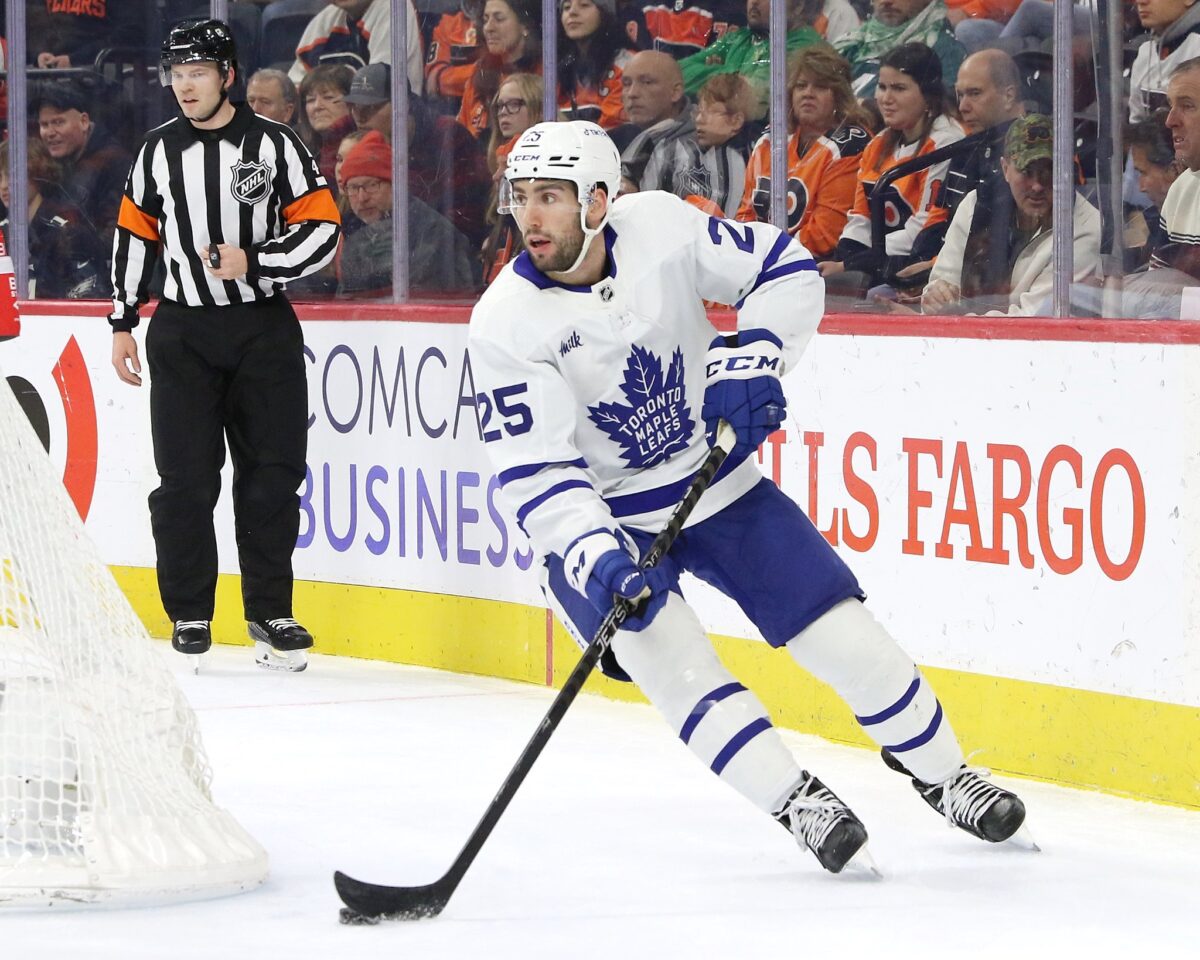As the Toronto Maple Leafs face a roster crunch with Connor Dewar and Jani Hakanpaa‘s impending returns, there’s speculation that general manager Brad Treliving might consider moving Conor Timmins. There are logical reasons to do so: freeing up cap space, balancing the defensive roster, and possibly adding an asset in return.
Related: NHL Rumors: Canucks, Oilers, Predators, Rangers
However, trading Timmins now would be a mistake for two reasons. First, he’s just starting to come into his own. Second, he has demonstrated qualities that make him far too valuable to be labeled “expendable.”
Timmins is Finding His Groove as a Steady, Reliable Defenseman
Timmins has steadily proven his worth on the Maple Leafs’ blue line, providing a rare combination of defensive stability and puck-moving ability. He plays a simple, straightforward game, which brings a level of consistency the Maple Leafs need as they work toward becoming a well-rounded team capable of handling playoff pressure. His recent play shows he’s comfortable in his role and learning to use his skillset effectively within Toronto’s system.

Timmins doesn’t overcomplicate plays. Instead, he relies on solid fundamentals to ensure his game is reliable night after night. This “less is more” approach makes him a stabilizing force, which is valuable on a team where flashy offensive defenders often overshadow those who are steady, responsible, and consistent. His presence gives the team flexibility, especially if injuries arise. Moving him at this stage would mean sacrificing a valuable depth piece just beginning to hit his stride.
Timmins Is Just Starting to Showcase His Offensive Ability
While known for his steady-enough defensive play, Timmins has also shown that he can contribute offensively. His recent goal against the Canadiens—an even-strength score—shows his growing confidence and playmaking ability. With more NHL experience, he’s starting to read the game better. He’s picking his spots to jump into the play without compromising his defensive responsibilities.
Related: Matthew Knies’ Physical Play Is Powering the Maple Leafs Offense
In just 14 games, Timmins has registered four points, demonstrating he has an offensive upside. He’s capable of making intelligent passes and supporting the offense from the blue line. He’s been able to impress his new coach by fitting his game into the team’s new north-south structure. This fits perfectly into head coach Craig Berube’s vision of how and when defensemen should contribute to the attack. As he’s finding his footing and building confidence within this system, trading him now would be short-sighted.
Timmins’ Game Complements the Maple Leafs’ Defensive Needs
As Toronto looks to build a defensively-responsible team, Timmins’ style of play aligns perfectly. Unlike Hakanpaa, who brings a physical, stay-at-home presence, Timmins balances offense and defense to fill a different, but equally important, role. Hakanpaa’s physicality is valuable (or so we think because we have yet to see it in action on the ice.) However, a one-dimensional focus on physical defense could limit the team’s versatility. With Timmins, the Maple Leafs have a dependable option who can transition the puck effectively, a skill that can’t be undervalued, especially as games get faster and more strategic.

In an NHL season, depth matters, and Timmins has proven he can be more than just a stopgap. So far, he’s fended off competitors for his spot in the lineup. That fact, in itself, speaks to the coaches’ perceptions of his reliability and skill. He’s the kind of player who gives Toronto lineup flexibility, especially when injuries inevitably happen, and his contributions make it hard to justify letting him go for what could amount to a minimal return.
Consistency and Growing Confidence Make Him an Asset, Not a Liability
At 26 years old, Timmins shows a level of poise that indicates he’s entering the prime of his career. His recent performances underscore his ability to contribute at both ends of the ice. The numbers tell the story of a solid blue liner. Timmins has blocked 18 shots this season, recorded eight hits, and posted a plus-5 rating. He’s improving his responsible two-way game.
Related: How Jake McCabe Elevates the Toronto Maple Leafs’ Blue Line
Moving him as a “roster-fix casualty” as the Maple Leafs strive to improve their overall defensive structure seems wrong-minded. He’s unique to the team’s defensive corps and isn’t an easily-expendable player. Timmins has earned his spot through hard work, steady growth, and an adaptable, all-around game.
Conclusion: Timmins Is Far Too Good to Trade Right Now
While there might be good reasons to move a roster player to alleviate cap concerns, whittle away at a contract or two, or make room for Hakanpaa, the Maple Leafs would be wise to keep him. His simple, efficient style, offensive contributions, reliability, and growing skills make him an asset Toronto needs as it builds a deep, balanced roster.
The Maple Leafs have found a player in Timmins whose upside has yet to be reached. If depth and versatility can make the difference between a playoff run and an early exit, keeping Timmins isn’t just wise; it’s crucial.
